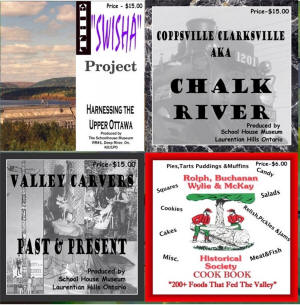|
History In The New Millenium
(RBWM Historical Society)

by John Wright
Our
Virtual Museum Page
As
we entered the new Millenium, and as the "Digital Age" opened
before us, we saw a need to move into it in order to fully
fulfill our mandate as set out in the Objectives of our
Constitution, to "Preserve and Present Historical data
pertaining to the area".
To this end in 2003 we joined the Canadian Heritage Information
Network, a branch of Dept of Canadian Heritage, Govt of Canada
and with financial support to purchase Computer equipment from
the Virtual Museum of Canada we produced a history of the
building of the Hydro Electric dam at Rolphton/DesJoachims. The
following is summary of this project which can be viewed through
a link from our website
http://bright-ideas-software.com/Schoolhouse/
The School House Museum's presentation of "The SWISHA
Project" leads the viewer through the 1940s
construction by the Ontario Hydro Power Corporation of a major
hydro electric power dam on the Ottawa River at Des Joachims
(pronounced locally as D`Swisha
Quebec, Canada. It includes
life in the construction camps, the dislocation/relocation of
communities up stream, the effect of the dam on the lumber
industry on the river, the creation of the Hydro Colony at
Rolphton, Ontario, life in the Colony, the dismantling of the
Colony and relocation of its buildings. The viewer can access
details of the project in Ontario Hydro's 1948 Publication, "Des
Joachims Generating Station, Ottawa River," and a month-by-month
account of the dam's construction as detailed in the final
edition of the Ontario Hydro Construction Division's
publication, "DesJoachims News." An account of the project, as
seen through the eyes of freelance writer, Bruce McLeod, and
published in the November 1950 issue of Maclean`s magazine under
the title, "The Biggest Damn Dam I Ever See," brings a human
touch for the viewer. The presentation concludes with an
acknowledgment of the sacrifice made by those who lost their
lives during construction.
In 2005 the School House Museum was successfull in having the
application for a second "Community Memories" project accepted
by the Virtual Museum of Canada. This project tytled
"Coppsville/ Clarksville aka Chalk River" targeted the birth and
growth of the community of Chalk River.
The Coppsville/Clarksville aka Chalk River's
summary follows.
In this project, the School House Museum will endeavor to open a
window in digital format on the history of the community of
Chalk River , Ontario, Canada. We wish to thank local historian
Mr. Maurice Blimkie for his granting of unlimited access to his
1979 publication, "Historical Account Of The Village of Chalk
River." In this book Mr Blimkie documented a wide range of
facets of the community's past. We hope to draw upon these
threads of history, expand upon then, and extend them into the
present day (2005).
For background purposes, the Introduction to Mr
Blimkie's book follows.
For many years before its name became synonymous with the
Canadian nuclear industry, Chalk River, Ontario was a vibrant
centre of activity in the Upper Ottawa Valley. Most early
pioneers lived within a three-mile radius of the village as it
exists today, but some settled as far away as the Deep River and
Wylie districts. The School House Museum explores mysteries and
misconceptions about the town, such as its origins and how it
got its name. Many believe, for example, that Chalk River owes
its existence to the building of the Canadian Pacific Railway
(C.P.R.). While the railroad did contribute to the areas development, farmers and lumbermen who relied on the Ottawa
River for transportation had settled in the region long before
the railroad was built. Using digital technology, the School
House Museum opens a window on all these aspects of Chalk
River history.
Encouraged by the success and acceptance of it's first two
projects, the Schoolhousae Museum made application in 2007 for a
third Community Memories project, "Valley Carvers, Past and
Present". This project was accepted and with input from other
Museums in the Renfrew County Museums Network, went on line at
Easter of 2008.
The Summary of "Valley Carvers " follows.
The woodcarvers of Renfrew County have earned national and
international renown for works spanning a broad spectrum from
the finest wooden jewellery to the tallest totem pole in
Ontario.This Community Memories exhibit chronicles the lives and
showcases the artistry of Renfrew County's woodcarvers from 1846
to the present day.To achieve this substantial project, the
Schoolhouse Museum collaborated with other members of the
Renfrew County Museums Network, documenting woodcarvings from
all corners of this expansive county.While some woodcarvers made
a living selling their works, many indulged in the craft for
personal satisfaction, giving their carvings to friends and
family as gifts. These works have also been recorded after an
extensive search of the county through local media. In order to
present a full and accurate history of Renfrew County's
celebrated art form, the exhibit features newspaper clippings
and photographs saved by descendants of early carvers, as well
as excerpts from books and articles, including the Tamarack
Magazine of Deep River High School.
Acknowledgements:
We would
like to thank all who assisted in the creation of this project,
including, but not limited to, carvers currently active, retired
carvers, families
of deceased carvers, members of the Renfrew County Museums
Network, Folk Art collectors,and the local Media.
Rolph,
Buchanan, Wylie and McKay
Historical Society Cook Book
With input
from many community members, the RBWM Historical Society Cook
Book was assembled and released in printed form in December of
1987 as a fund raiser toward the purchase of the current Museum
property. Museum records show a price of $6.95 each, and in
January of 1988, sales income of $977.00. In 2004, all 204
recipes were converted to digital format and released on CD.
|